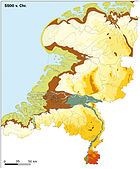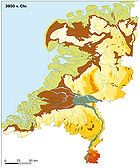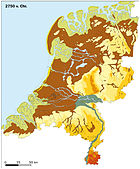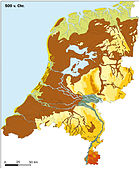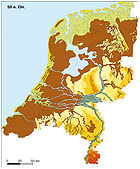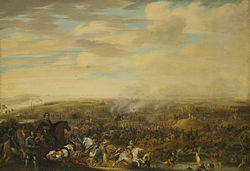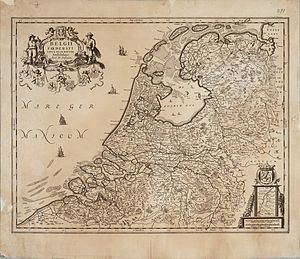
History of the Netherlands
Did you know...
This Schools selection was originally chosen by SOS Children for schools in the developing world without internet access. It is available as a intranet download. Before you decide about sponsoring a child, why not learn about different sponsorship charities first?
The present-day territory of the Netherlands has been inhabited since the paleolithic era. The historical period sets in with the Roman Empire, as the parts south of the Rhine were included in the province of Gallia Belgica, and later of Germania Inferior. The country was inhabited at the time by various Germanic tribes, and the south was inhabited by Gauls, who merged with newcomers from other Germanic tribes during the migration period. The Salian Franks migrated to Gaul from this region, establishing by the 5th century the powerful Merovingian dynasty.
In the medieval period, the Low Countries (roughly present-day Belgium and the Netherlands) consisted of various counties, duchies and dioceses belonging to the Duchy of Burgundy and to the Holy Roman Empire. These were united into one state under Habsburg rule in the 16th century. The Counter-Reformation following the success of Calvinism in the Netherlands, and the attempts to centralise government and suppress religious diversity led to a revolt against Philip II of Spain. On 26 July 1581, independence was declared, and finally recognised after the Eighty Years' War (1568–1648). The years of the war also marked the beginning of the Dutch Golden Age, a period of great commercial and cultural prosperity roughly spanning the 17th century.
Around 1600, the Netherlands were considered a country, but it was not until 1648, with the Treaty of Münster, that the Dutch and Spain formally made peace.
After the French occupation at the beginning of the 19th century, the Netherlands started out as a monarchy, governed by the House of Orange. However, after a conservative period, strong liberal sentiments could no longer be ignored, and the country became a parliamentary democracy with a constitutional monarch in 1848. It has remained so to this day, with a brief interruption during the occupation by Nazi Germany.
The Netherlands is now a modern, industrialised nation and a large exporter of agricultural products. International trade (literally 'overseas') has always been a central aspect of the Dutch economy (also influencing the culture) and was also an important reason for the struggle for independence and cause of the ensuing wealth.
Prehistory
The Netherlands have been inhabited since the last ice age; the oldest artefacts that have been found are from the Hoogeveen interstadial of the Saalian glaciation. During the last ice age, the Netherlands had a tundra climate with scarce vegetation. The first inhabitants survived as hunter-gatherers. After the end of the ice age, the area was inhabited by various palaeolithic groups. One group made canoes (Pesse, around 6500 BC) around 8000 BC, a Mesolithic tribe resided near Bergumermeer ( Friesland).
Agriculture arrived in the Netherlands somewhere around 5000 BC, by the Linear Pottery culture (probably Central European farmers) but was only practised on the loess plateau in the very south (Southern Limburg). Their knowledge was not used to build farms in the rest of the Netherlands owing to a lack of animal domestication and proper tools.
Autochtoneous hunter-gatherers of the Swifterbant culture are attested from 5600 BC onwards. They had strong ties to rivers and open water and are genetically related to the South Scandinavian Ertebølle culture (5300-4000 BC). To the west, the same tribes might have built hunting camps to hunt winter game, such as seals. There is even some evidence of small settlements in the west. These people made the switch to animal husbandry between 4800-4500 BC. They are thought to have developed an agricultural society in an indigenous development as early as 4300-4000 BC, that featured the introduction of small proportions of grains into a traditional broad-spectrum economy. The culture developed into the Westgroup of the farming Funnelbeaker culture, that inhabited Northern Netherlands and Northern Germany to the Elbe river. In this period the first notable remains of Dutch prehistory were erected: the dolmens, large stone grave monuments. They are found in the province of Drenthe, and were probably built between 4100 and 3200 BC. To the west the Vlaardingen culture (around 2600 BC), an apparently more primitive culture of hunter-gatherers survived well into the Neolithicum.
The region was the possible location of origin of the extremely expansive Bell Beaker culture.
Around 2950 BC the Netherlands witnessed the transition of Funnelbeaker farming culture to Corded Ware pastoralist culture. This change has been proposed to be a quick, smooth and internal change of culture and religion that occurred during two generations, probably inspired from developments in Eastern Germany, however without the implication of new immigrations. This new culture evolved into the influential Bell Beaker culture. As derived from the western extremity of the Corded Ware culture, otherwise marginal groups took advantage of their contacts by sea and rivers and started a diaspora of North West European culture from Ireland to the Carpatian Basin and south along the Atlantic coast and following the Rhone valley until Portugal, North Africa and Sicily, even penetrating northern and central Italy. The first evidence of the use of a wheel dates from this period, about 2400 BC. This culture also experimented with copper working, of which some evidence (stone anvils, copper knives, a copper spearhead) was found on the Veluwe. Each copper finding shows that there was trade with other "countries", as natural copper cannot be found in the Dutch soil.
The Bronze age probably started somewhere around 2000 BC. The bronze tools in the grave of "The smith of Wageningen" illustrated their quest for knowledge. ( Typical Dutch Bronze Age items) After this finding, more Bronze Age findings appear, such as Epe, Drouwen, etc. The many findings of rare (and therefore valuable) objects such as tin beads on a necklace in Drenthe suggest Drenthe as a trade centre of the Netherlands in the Bronze Age.
The stock of broken bronze objects, meant to recycle (Voorschoten) tells us something about the value of bronze in the Bronze Age, which lasted until about 800 BC. Typology of Dutch Bronze Age axes Typical Bronze Age objects are: knives, swords, axes, fibuale, bracelets, etc. Most Bronze Age objects were found in Drenthe. One item shows that merchants travelled far: large bronze situalae (buckets) were manufactured somewhere in eastern France or in Switzerland, for mixing wine with water (a Roman / Greek custom).
The Iron Age brought fortune to the Netherlands, because iron ore was found in the North ("moeras ijzererts") as well as in the centre (natural "balls" with iron in them, at the Veluwe) as well as in the South (red iron ore near the rivers in Brabant). The smiths could thus travel from small settlement to settlement with bronze and iron, fabricating tools on-demand such as axes, knives, pins, arrowheads, swords, etc. There is even evidence of the use of "damast-forging"; an advanced way to forge metal (swords) with the advantage of flexible iron with the strength of steel.
The wealth of the Netherlands in the Iron Age is seen at the "King's grave in Oss" (about 500 BC), where a king was buried with some extraordinary objects, including an iron sword with an inlay of gold and coral. He was buried in the largest grave mound of Western Europe, which was 52 m wide.
At the time of the Roman arrival, the Netherlands had been settled by Germanic tribes, such as the Tubanti, the Canninefates, and the Frisians, who had arrived around 600 BC. Celtic tribes settled the South, among them the Eburones and the Menapii. Several Germanians settled south of the Rhine at the beginning of the Roman settlement, and formed the Germanic tribe of the Batavians and the Toxandri. The Batavians were regarded as good soldiers and fought in many important wars, for instance the conquest of Dacia (Romania) by the emperor Trajan. In later nationalistic views, the Batavians were regarded as the "true" forefathers of the Dutch, as reflected in the name of the later Batavian Republic. These Batavians were replaced or absorbed by the Salian Franks that originally came from Overijssel and beyond, as attested by the geographical area of Salland. These Germanic people might have preserved some religious features of the earliest Swifterbant people, like the worship of the cow and fertility gods that distinguish them from their Germanic neighbours. The Dutch language as it emerged in history derived from the language of the Franks.
Roman era
After Julius Caesar conquered Gaul, he conquered Belgium and The Netherlands around the year 58 BC, which made it the northern border of the European mainland. They built the first cities and first created the Roman province of Germania Inferior. For most of the large area of Roman occupation in the Netherlands, the boundary of the Roman Empire lay along the Rhine. Romans built the first military forts and cities in the Netherlands. The most important of these were Utrecht, Nijmegen, and Maastricht. The northern part of the Netherlands, which was outside the Roman Empire and where the Frisians lived (and still do), was also heavily influenced by its strong southern neighbour. The Romans also introduced writing.
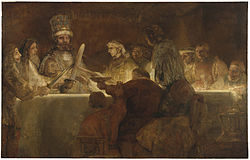
The relationship with the original inhabitants was on the whole quite good; many Batavians even served in the Roman cavalry. Batavian culture was influenced by the Roman one, resulting among other things in Roman-style temples such as the one in Elst, dedicated to local gods. Also the trade flourished: the salt used in the Roman empire was won from the North Sea and remains are found across the whole Roman empire. However, this did not prevent the Batavian rebellion of 69 AD, a very successful revolt under the leadership of Batavian Gaius Julius Civilis. Forty castellae were burnt down because the Romans violated the rights of the Batavian leaders by taking young Batavians as their slaves. Other Roman soldiers (like those in Xanten and the auxiliary troops of Batavians and Caninefatae from the legions of Vitellius) joined the revolt, which split the northern part of the Roman army. April 70 AD, Vespasianus sent a few legions to stop the revolt. Their commander, Petilius Cerialis, eventually defeated the Batavians and started negotiations with Julius Civilis on his home ground, somewhere between the Waal and the Maas near Noviomagus (Nijmegen) or—as the Batavians probably called it—Batavodurum.
(Source: Historiae by Tacitus, 1st century AD). Translation into Dutch by the Radboud Universiteit, Nijmegen
The Roman civilisation in the area was eventually overrun in the mass migration of Germanic peoples (later known as the Völkerwanderung).
Holy Roman Empire
The newcomers merged with the original inhabitants to create three peoples in the Low Countries: the Frisians along the coast, the Saxons in the east and the Franks in the south. The Franks became Christians after their king Clovis I converted in 496. Christianity was introduced in the north after the conquest of Friesland by the Franks. Anglo-Saxon missionaries such as Willibrord, Wulfram and Boniface were active in converting these nations to Christianity. Boniface was martyred by the Frisians in Dokkum (754). The Saxons in the east were converted before the conquest of Saxony, and became Frankish allies.
In the 7th and 8th centuries, the Frankish chronologies mention this area as the kingdom of the Frisians. This kingdom comprised the coastal provinces of the Netherlands and the German North Sea coast. During this time, the Frisian language was spoken along the entire southern North Sea coast and, today, this region is sometimes referred to as Greater Frisia or Frisia Magna. The 7th-century Frisian realm ( 650- 734) under the kings Aldegisel and Redbad, had its centre of power in the city Utrecht. Its end came in 734 at the Battle of the Boarn, when the Frisians were defeated by the Franks, who then conquered the western part up to the Lauwers. They conquered the area east of the Lauwers in 785, when Charlemagne defeated Widukind.
The Netherlands belonged to the Frankish empire of Charlemagne, with its heartland in what is today Belgium and northern France, and spanning France, Germany, northern Italy and much of Western Europe.
In 843, the Frankish empire was divided into three parts, giving rise to France in the west, Germany in the east and a middle empire that lay between the two. Most of the Netherlands was part of the middle empire. Later this middle empire was split: most of the contemporary Dutch-speaking lands became a part of Germany; Flanders became part of France.
From 800 AD to 1000 AD, the Low Countries suffered considerably from Viking raids. Most of the Netherlands was occupied by the Viking Rorik from about 840 to 880, who ruled from Dorestad. This was about the same time that France and Germany were fighting for supremacy over the middle empire. Resistance to the Vikings, if any, came from local nobles, who gained in stature as a result. Viking supremacy ended in 920 when King Henry of Germany liberated Utrecht.
The German kings and emperors dominated the Netherlands in the 10th and 11th century. Germany was called the Holy Roman Empire after the coronation of King Otto the Great as emperor. The Dutch city of Nijmegen used to be the spot of an important domain of the German emperors. Several German emperors were born and died there. (Byzantine empress Theophanu died in Nijmegen for instance.) Utrecht was also an important city and trading port at the time. German officials closely watched the count of Westfriesland (Holland) in the Rhine delta. The count rebelled in 1018. The county was destined to become a part of Utrecht after 1018, but the difficulties between the pope and the emperor saved the county.
Much of the western Netherlands was barely inhabited between the end of the Roman period and around 1100. Around 1000, farmers from Flanders and Utrecht began purchasing the swampy land, draining it and cultivating it. This process happened quickly and the uninhabited territory was settled in only a few generations. They built independent farms that were not part of villages, something unique in Europe at the time. Before this happened the language and culture of most of the people who lived in the area that is now Holland were Frisian. The area was known as "West Friesland" (Westfriesland). As settlement progressed, the area quickly became Dutch. This area became known as ' Holland' in the 12th century. (The part of North Holland situated north of the 'IJ' is still colloquially known as West Friesland).
Around 1000 AD there were several agricultural developments (described sometimes as an agricultural revolution) that resulted in an increase in production, especially food production. The economy started to develop at a fast pace, and the higher productivity allowed workers to farm more land or to become tradesmen. Guilds were established and markets developed as production exceeded local needs. Also, the introduction of currency made trading a much easier affair than it had been before. Existing towns grew and new towns sprang into existence around monasteries and castles, and a mercantile middle class began to develop in these urban areas. Commerce and town development increased as the population grew.
The crusades were popular in the Low Countries and drew many to fight in the Holy Land. At home, there was relative peace in Europe. Viking pillaging had stopped. Both the Crusades and the relative peace at home contributed to trade and the growth in commerce.
Cities arose and flourished, especially in Flanders and Brabant. As the cities grew in wealth and power, they started to buy certain privileges for themselves from the sovereign, including city rights, the right to self-government and the right to pass laws. In practice, this meant that the wealthiest cities became quasi-independent republics in their own right. Two of the most important cities were Brugge and Antwerp which would later develop into some of the most important cities and ports in Europe.
The Holy Roman Empire was not able to maintain political unity. In addition to the growing independence of the towns, local rulers turned their counties and duchies into private kingdoms and felt little sense of obligation to the emperor who governed over large parts of the nation in name only. Large parts of what now comprise the Netherlands were governed by the Count of Holland, the Duke of Gelre, the Duke of Brabant and the Bishop of Utrecht. Friesland and Groningen in the north maintained their independence and were governed by the lower nobility.
The various feudal states were in a state of almost continual war. Gelre and Holland fought for control of Utrecht. Utrecht, whose bishop had in 1000 ruled over half of what is today the Netherlands, was marginalised as it experienced continuing difficulty in electing new bishops. At the same time, the dynasties of neighbouring states were more stable. Groningen, Drenthe and most of Gelre, which used to be part of Utrecht, became independent. Brabant tried to conquer its neighbours, but was not successful. Holland also tried to assert itself in Zeeland and Friesland, but its attempts failed.
Friesland in the north continued to maintain its independence during this time. It had its own institutions (collectively called the "Frisian Freedom") and resented the imposition of the feudal system and the patriciate found in other European towns. They regarded themselves as allies of Switzerland. The Frisian battle cry was "better dead than a slave". They later lost their independence when they were defeated in 1498 by the German Landsknecht mercenaries of Duke Albrecht of Saxony-Meissen.
|
History of the Low Countries
|
||||
|---|---|---|---|---|
| Frankish Kingdom (5th to 10th century) |
Frisian Kingdom (600–734) |
|||
| Carolingian Empire after 800 | ||||
| West Francia ("France") | Independent Kingdom of Middle Francia (Lotharingia) (843–870) |
|||
| Flanders and Lotharingia in Kingdom of West Francia (870–880) | ||||
County of Flanders (862–1384) and other principalities (10th–14th centuries) |
Kingdom then Duchy of Lotharingia in East Francia ("Germany") (880–1190) |
|||
Prince-Bishopric of Liège (980–1794) Duchy of Bouillon (988–1795) Imperial Abbey of Stavelot-Malmedy (1138–1795) |
Duchy of Brabant (1183–1430) and other principalities (10th–15th centuries) |
County/ Duchy of Luxembourg (963–1443) |
County of Holland (880–1432) and other principalities (10th–15th centuries) |
|
| Habsburg Netherlands ( Seventeen Provinces) (1482–1556) |
||||
| Spanish Netherlands (Southern Netherlands) (1556–1714) |
Dutch Republic (1581–1795) |
|||
Austrian Netherlands (Southern Netherlands) (1714–1795) |
||||
Liège Revolution (1789–1792) |
United States of Belgium (1790) |
|||
Part of the French Republic (1795–1804) and the French Empire (1804–1815) |
Batavian Republic (1795–1806) |
|||
Kingdom of Holland (1806–1810) |
||||
United Kingdom of the Netherlands (1815–1830) |
||||
Kingdom of Belgium (since 1830) |
Gr Duchy Luxembourg (personal union) |
Kingdom of the Netherlands (since 1830) |
||
Gr Duchy Luxembourg (since 1890) |
||||
Burgundian period
Most of what is now the Netherlands and Belgium was eventually united by the Duke of Burgundy in 1433. Before the Burgundian union, the Dutch identified themselves by the town they lived in, their local duchy or county or as subjects of the Holy Roman Empire. The Burgundian period is when the Dutch began the road to nationhood.
The conquest of the county of Holland by the Duke Philip the Good of Burgundy was an odd affair. Leading noblemen in Holland in fact invited the duke to conquer Holland, even though he had no historical claim to it. Some historians say that the ruling class in Holland wanted Holland to integrate with the Flemish economic system and adopt Flemish legal institutions. Europe had been wracked by many civil wars in the 14th and 15th centuries, while Flanders had grown rich and enjoyed peace.

After a few years of conflict, the countess of Holland was deposed in favour of the Burgundian dukes. Holland's trade developed rapidly, especially in the area of shipping and transport. The new rulers defended Dutch trading interests. The fleets of Holland defeated the fleets of the Hanseatic League several times. Amsterdam grew and in the 15th century became the primary trading port in Europe for grain from the Baltic region. Amsterdam distributed grain to the major cities of Belgium, Northern France and England. This trade was vital to the people of Holland, because Holland could no longer produce enough grain to feed itself. Land drainage had caused the peat of the former wetlands to reduce to a level that was too low for drainage to be maintained.
Gelre resented Burgundian rule. It tried to build up its own state in northeast Netherlands and northwest Germany. Lacking funds in the 16th century, Gelre had its soldiers provide for themselves by pillaging enemy terrain. These soldiers were a great menace to the Burgundian Netherlands. One notorious event was the pillaging of The Hague. Gelre was allied with France, England and Denmark, who wanted to put an end to the wealth of Flanders and Antwerp and Burgundian rule over the Low Countries.
Eighty Years' War
Through inheritance and conquest, all of the Low Countries became possessions of the Habsburg dynasty under Charles V in the 16th century, who united them into one state. The east of the Netherlands was occupied only a few decades before the Dutch struggle for independence. However, in 1548, eight years before his abdication from the throne, Emperor Charles V granted the Seventeen Provinces of the Netherlands status as an entity separate from both the Empire and from France with the Transaction of Augsburg. It was not full independence, but it allowed significant autonomy. In the Pragmatic Sanction of 1549 it was stated that the Seventeen Provinces could only passed on as a unified entity.
Charles was succeeded by his son Philip II of Spain. Unlike his father, who had been raised in Ghent (Belgium), Philip had little personal attachment to the Low Countries (where he had only stayed for four years), and thus was perceived as detached by the local nobility. A devout Catholic, Philip was appalled by the success of the Reformation in the Low Countries, which had led to an increasing number of Calvinists. His attempts to enforce religious persecution of the Protestants and his endeavours to centralise government, justice and taxes made him unpopular and led to a revolt. The Dutch fought for independence from Spain, leading to the Eighty Years' War (1568-1648). Seven rebellious provinces united in the Union of Utrecht in 1579 and formed the Republic of the Seven United Netherlands (also known as the "United Provinces"). The Oath of Abjuration or Plakkaat van Verlatinghe was signed on July 26 1581, and was the formal declaration of independence of the northern Low Countries from the Spanish king.
William of Orange (Slot Dillenburg, 24 April 1533 — Delft, 10 juli 1584), the founder of the Dutch royal family, led the Dutch during the first part of the war. The very first years were a success for the Spanish troops. However, subsequent sieges in Holland were countered by the Dutch. The Spanish king lost control of the Netherlands after the sack of Antwerp by mutinous Spanish soldiers killing 10,000 inhabitants. The conservative Catholics in the south and east supported the Spanish. The Spanish recaptured Antwerp and other Flemish and Dutch cities. Most of the territory in the Netherlands was recaptured, but not in Flanders, leading to the historical split between The Netherlands and Flanders. Flanders was the most radical anti-Spanish territory. Many Flemish fled to Holland, among them half of the population of Antwerp, 3/4 of Brugge and Ghent and the entire population of Nieuwpoort, Dunkerque and countryside. The war dragged on for another 60 years, but the main fighting was over. The Peace of Westphalia, signed on January 30, 1648, confirmed the independence of the United Provinces from Spain and Germany. The Dutch didn't regard themselves as Germans any more since the 15th century, but they officially remained a part of the Holy Roman Empire until 1648. National identity was mainly formed by the province people came from. Holland was the most important province by far. The republic of the Seven Provinces came to be known as Holland in foreign countries.
These events formed part of a wider turmoil. See Spanish Armada for a view of some of the history from further west.
Golden Age
During the Eighty Years' War the Dutch provinces became the most important trading centre of Northern Europe, replacing Flanders in this respect; Dutch ships hunted whales off Svalbard, traded spices in India and Indonesia (via the Dutch East India Company) and founded colonies in New Amsterdam (now New York), South Africa and the West Indies. In addition some Portuguese colonies were conquered, namely in Northeastern Brazil, Angola, Indonesia and Ceylon. This new nation flourished culturally and economically, creating what historian Simon Schama has called an "embarrassment of riches". Speculation in the tulip trade led to a first stock market crash in 1637, but the economic crisis was soon overcome. Due to these developments the 17th century has been dubbed the Golden Age of the Netherlands. As the Netherlands was a republic, it was largely governed by an aristocracy of city-merchants called the regents, rather than by a king. Every city and province had its own government and laws, and a large degree of autonomy. After attempts to find a competent sovereign proved unsuccessful, it was decided that sovereignty would be vested in the various provincial Estates, the governing bodies of the provinces. The Estates-General, with its representatives from all the provinces, would decide on matters important to the Republic as a whole. However, at the head of each province was the stadtholder of that province, a position held by a descendant of the House of Orange. Usually the stadtholdership of several provinces was held by a single man.
In 1650, the stadtholder William II, Prince of Orange suddenly died of smallpox; his son, the later stadtholder and subsequent king of England, William III, was born only 8 days later, hence leaving the nation without an obvious successor. Since the conception of the Republic, there had been an ongoing struggle for power between the 'regents', an informal elite of affluent citizens on the one hand and the House of Orange on the other hand, whose supporters, Orangists, were mainly to be found among the common people. For now, the regents seized the opportunity: there would be no new stadtholder (in Holland) for 22 years to come. Johan de Witt, a brilliant politician and diplomat, emerged as the dominant figure. Princes of Orange became the stadtholder and an almost hereditary ruler in 1672 and 1748. The Dutch Republic of the United Provinces was a true republic only from 1650–1672 and 1702–1748. These periods are called the First and Second Stadtholderless Eras.
In the year 1651, England imposed its first Navigation Act, which severely hurt Dutch trade interests. An incident at sea concerning the Act resulted in the First Anglo-Dutch War, which lasted from 1652 to 1654, ending in the Treaty of Westminster (1654), which left the Navigation Act in effect.
Part of the wealth of the Dutch came through slavery. In 1619 Dutch started with the slave trade between Africa and America, by 1650 becoming the pre-eminent slave trading country in Europe, a position overtaken by Britain around 1700. The port city of Amsterdam was the European capital of slavery, helping to manage the slave trade also of neighbouring nations and with up to 10,000 slaving vessels associated with the port.
1672 is known in the Netherlands as the "Disastrous Year" ( Rampjaar). England declared war on the Republic, (the Third Anglo-Dutch War), followed by France, Münster and Cologne, which had all signed alliances against the Republic. France, Cologne and Münster invaded the Republic. Johan de Witt and his brother Cornelis, who had accomplished a diplomatic balancing act for a long time, were now the obvious scapegoats. They were lynched, and a new stadtholder, William III, was appointed. An Anglo-French attempt to land on the Dutch shore could only just be repelled in three desperate naval battles under command of admiral Michiel de Ruyter. The advance of French troops from the south could only be halted by a costly inundation of its own heart land, by breaching river dykes. With the aid of friendly German princes, the Dutch succeeded in fighting back Cologne and Münster, after which the peace was signed with both of them, although some territory in the east was lost for ever. Peace was signed with England as well, in 1674 (Second Treaty of Westminster (1674)). In 1678, peace was made with France, although its Spanish and German allies felt betrayed by them signing the Treaty of Nijmegen.
In 1688, after three essentially undecided Anglo-Dutch Wars, the relations with England reached crisis level once again. Stadtholder William III decided he had to take a huge gamble when he was invited to invade England by Protestant British nobles feuding with William's father-in-law the Catholic James II of England. This led to the Glorious Revolution and cemented the principle of parliamentary rule and Protestant ascendency in England. James fled to France and William ascended to the English throne as co-monarch with his wife Mary, James' eldest daughter. This maneuver secured England as a critical ally of the United Provinces in its ongoing wars with Louis XIV of France. William was the commander of the Dutch and English armies and fleets until his death in 1702. During Williams reign as King of England his primary focus was leveraging British manpower and finances to aid the Dutch against the French. The combination continued after his death as the combined Dutch, British, and mercenary army conquered Flanders and Brabant, and invaded French territory before the alliance collapsed in 1713 due to British political infighting.
Many immigrants came to the cities of the province Holland in the 17th and 18th century, especially from Protestant parts of Germany. The amount of first generation immigrants from outside the Netherlands in Amsterdam was nearly 50% in the 17th and 18th century. If you add immigrants from the second and third generation and immigrants from the Dutch countryside, then the city was mainly inhabited by immigrants. People in most parts of Europe were very poor, and there was a lot of unemployment. But in Amsterdam there was always work. Tolerance was important, because a continuous influx of immigrants was necessary for the economy. Travellers were surprised that the police didn't control them in Amsterdam. The Netherlands also sheltered many famous refugees, including Flemish Protestants; Portuguese and German Jews; French Protestants (Huguenots); the founder of modern philosophy, Descartes; and, temporarily, the Pilgrim Fathers, who were to become symbols for the US tradition of republicanism.
The Dutch economy stagnated from the end of the 17th century until the end of the 18th century. The Netherlands slowly lost its position as the trading centre of Northern Europe. Amsterdam was a central financial market and bookmarket in Europe but lost this position to London.
After having gained its independence in 1648, the Netherlands tried in various coalitions to help to contain France, which had replaced Spain as the strongest nation of Europe. The end of the War of the Spanish Succession ( 1713) marked the end of the Dutch Republic as a major player. In the 18th century, it just tried to maintain its independence and stuck to a policy of neutrality. French invasions in 1672, 1701 and 1748 led to an overthrow of government.
Revolution, Republic and French rule
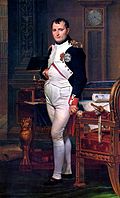
At the end of the 18th century, there was growing unrest in the Netherlands. There was conflict between the Orangists, who wanted stadtholder William V of Orange to hold more power, and the Patriots, who under the influence of the American wanted a more democratic form of government. The opening shot of this abortive 'Batavian' revolution might be considered the manifesto published by Joan van der Capellen tot den Pol, the founder of the 'Patriots' in 1781: Aan het Volk van Nederland (To the people of the Netherlands).
After the Netherlands became the second nation to recognise US independence, the British declared war. This Fourth Anglo-Dutch War (1780–1784) proved a disaster for the Netherlands, particularly economically. Its peace treaty, according to Fernand Braudel "sounded the knell of Dutch greatness."
In 1785 there was a rebellion by the Patriots, an armed insurrection by local militias determined to defend municipal democracies in certain Dutch towns. "Seen as a whole this revolution is a string of violent and confused events, accidents, speeches, rumours, bitter enmities and armed confrontations." says Braudel, who sees it as a forerunner of the French Revolution, with the constant slogan "vrijheid". But the House of Orange, backed by British policy, called upon their Prussian relatives to suppress it. The Orangist reaction was severe. No one dared appear in public without an orange cockade; furthermore there were lynchings. The old burgomasters were replaced by a small unpaid Prussian army which was billeted in the Netherlands and which supported themselves with looting and extortion. Many Patriots fled the country to Brabant or France -- perhaps 40,000 in all.
Against this background it is less surprising that, after the French Revolution, when the French army invaded and occupied the Netherlands in 1795, the French encountered so little united resistance. William V of Orange fled to England. The Patriots proclaimed the short-lived Batavian Republic, but government was soon returned to stabler and more experienced hands. In 1806 Napoleon restyled the Netherlands (along with a small part of what is now Germany) into the Kingdom of Holland, with his brother Louis (Lodewijk) Bonaparte as king. This too was short-lived, however. Napoleon incorporated the Netherlands into the French empire after his brother put Dutch interests ahead of those of the French. The French occupation of the Netherlands ended in 1813 after Napoleon was defeated, a defeat in which William VI of Orange played a prominent role.
On November 30 1813, William VI of Orange landed in Scheveningen and was proclaimed the Sovereign Prince of the United Netherlands (Dutch: Vereenigde Nederlanden). This state was superseded by the United Kingdom of the Netherlands in 1815, after the unification of the northern Netherlands with the Austrian Netherlands under William VI of Orange.
Shortly after his flight to England Stadtholder William V sent the Kew Letters in which he gave the Dutch colonies in 'safekeeping' to Great Britain and ordered the colonial governors to surrender to the British. This helped put an end to much of the Dutch colonial empire. Guyana and Ceylon never returned to Dutch rule, though other colonies were initially returned by the Treaty of Amiens. The Cape Colony, which had changed hands several times, remained British after 1806. Other colonies, including what is today Indonesia, were returned to the Netherlands under the Anglo-Dutch Treaty of 1814. Ten years later there was another treaty—the Anglo-Dutch Treaty of 1824.
Monarchy
After the Napoleonic era the Netherlands were put back on the map of Europe. The country had always been part of the precarious balance of power that had kept France in check. Particularly the Russian tsar wanted the Netherlands to resume this role and wanted the colonies to be returned. A compromise was struck with the United Kingdom before the Congress of Vienna, whereby only the Dutch East Indies were returned, and the north and south of the Netherlands became a united sovereign state for the first time ever in 1815, with two capitals: Amsterdam and Brussels, in a secret protocol, known as the Eight Articles of London. The country became a monarchy, with the son of the last stadtholder, William V, the Prince of Orange as king William I. In addition, king William I became hereditary Grand Duke of Luxembourg. The French-speaking ruling elite in the southern Netherlands soon began feeling like second-class citizens. The primary factors that contributed to this feeling were religious (the predominantly Roman Catholic South versus the mostly Protestant North), economic (the South was industrializing, the North had always been a merchants' nation) and linguistic (the French-speaking South was not just Wallonia, but also extended to the French-speaking bourgeoisie in the Flemish cities). In 1830 the situation exploded, the Belgians revolted and declared independence from the North. King William sent an army in 1831, but it was forced to retreat after a few days when the French army was mobilised. The North refused to recognise Belgium until 1839.
In 1848 unrest broke out all over Europe. Although there were no major events in the Netherlands, these foreign developments persuaded king William II to agree to liberal and democratic reform. That same year the liberal Johan Rudolf Thorbecke was asked by the king to rewrite the constitution, turning the Netherlands into a constitutional monarchy. The new document was proclaimed valid on November 3 of that year. It severely limited the king's powers (making the government accountable only to an elected parliament), and it protected civil liberties. The relationship between monarch, government and parliament has remained essentially unchanged ever since.
The personal union between the Netherlands and Luxembourg ended in 1890 when William III of the Netherlands, the last Dutch male head of state so far, died, as ascendancy rules in Luxembourg prevented a woman from becoming ruling Grand Duchess.
By the end of the 19th century, in the New Imperialism wave of colonisation, the Netherlands extended their hold on Indonesia. In 1860 Multatuli wrote Max Havelaar, one of the most famous books in the history of Dutch literature, criticising the exploitation of the country and its inhabitants by the Dutch, although the indigenous princes as their proxies were not spared either.
20th century
The Netherlands had been neutral for a long time after the Seven Years War since their wealth had grown but their military had done quite the contrary. The Dutch were unable to defend themselves in case of war and therefore chose the policy of Neutrality, a choice that would influence the Dutch involvement in the wars to come.
World War I
Marshal Count Alfred von Schlieffen designed the Schlieffen Plan in 1905. A plan to invade France while passing through neutral Belgium and neutral Netherlands. In 1908 Von Schlieffen's successor Helmuth von Moltke the Younger changed the plan, and chose not to invade the Netherlands in case of war but instead conserving Dutch neutrality. The simple reason being that the Netherlands supplied many goods to Germany and the Netherlands would be a vast resource of raw products such rubber, tin, quinine and petroleum came through the port of Rotterdam, and of course food. 50 Percent of Dutch agricultural imports until 1916 came through Rotterdam. After that, the USA joined the war and the Dutch suffered from the blockade, although to a lesser extent than Germany. Therefore the economic importance of Dutch neutrality was lost..
But there were other factors that made it valuable for both the Allies and the Central Powers for the Netherlands to be neutral. The Netherlands controlled the mouths of three rivers, the Scheldt, the Rhine and the Meuse river. Germany had interest in the Rhine since it was connected to the industrial area the Ruhr and connected it with the Dutch port of Rotterdam. England had interest in the Scheldt river, and the Meuse went into France. All countries had interest in keeping the other out of the Netherlands, so no ones interest could be taken away or be changed. In case one country would invade the Netherlands, another one would surely counter- attack to defend their interest in the rivers. It was too big a risk for any of the belligerent nations, no one wanted to risk fighting on another front..
Yet, the Dutch were not uneffected by the war. The troops were mobilised and conscription was introduced under harsh criticism of the opposition parties. Food shortages were vast due to the control that the belligerents excerised on the Dutch. Each wanted their share of the Dutch product. That way potatoes became valuable because Britain had demanded so much from the Dutch. Food riots even broke out in the country..
A big problem was the smuggling. When Germany had conquered Belgium, the Allies saw it as enemy territory and stopped exporting to Belgium. Food became rare for the Belgian people, for the Germans seized all food and it gave the opportunity for the Dutch citizens to start to smuggle. This, however, caused great problems in the Netherlands, including inflation and more food shortages. The Allies demanded that the Dutch would stop the smuggling, and the government took measures to remain neutral. The government placed many cities under 'state of siege'. On January 8 1916, a five kilometre zone was created by the government along the border. In that zone, goods could only be moved on the main roads, with a permit.
Between the Wars
Although both houses of the Dutch parliament were elected by the people, only men with high incomes were eligible to vote until 1917, when pressure from socialist movements resulted in elections in which all men were allowed to vote. In 1919 women also got the right to vote.
The worldwide Great Depression of 1929 and the early 1930s had crippling effects on the Dutch economy, which lasted longer than they did in most European countries. The long duration of the Great Depression in the Netherlands is often explained by the very strict fiscal policy of the Dutch government at the time, and its decision to adhere to the Gold Standard much longer than most of its trading partners. The depression led to large unemployment and poverty, as well as increasing social unrest (for more details: the Great Depression in the Netherlands). The rise of Nazism in Germany did not go unnoticed in the Netherlands, and there was growing concern over the possibility of armed conflict, but most Dutch citizens thought that Germany would again respect Dutch neutrality.
World War II
At the outbreak of World War II in 1939, the Netherlands declared their neutrality again. However, on May 10, 1940, Nazi Germany launched an attack on the Netherlands and Belgium and overran most of the country quickly, fighting against a poorly-equipped Dutch army. By May 14, fighting was only occurring in isolated locations, when the Luftwaffe bombed Rotterdam, the second largest city of the Netherlands, killing about 900 people, destroying large parts of the city, and leaving 78,000 homeless. Following the bombardment and German threats of the same for Utrecht, the Netherlands capitulated on May 15 (except the province of Zeeland). The royal family and some military forces fled to the United Kingdom. Some members of the royal family eventually moved to Ottawa, Canada until the Netherlands was liberated; Princess Margriet was born during this Canadian exile.
About 140,000 Jews lived in the Netherlands at the beginning of the war; persecution of the Jews started shortly after the invasion. At the end of the war, only 40,000 Jews were alive. Of the 100,000 Jews that didn't hide, only 1000 survived the war. One who perished was Anne Frank, who would gain posthumous world-wide fame when her diary, written in the Achterhuis (backhouse) while hiding from the Nazis, was found and published.
Resentment about the German presence grew as the occupation regime became harsher, prompting many Dutch to join the resistance. However, collaboration was not uncommon either; many thousands of young Dutch males also volunteered for combat service on the Russian Front with the Waffen-SS.
Japanese forces invaded the Dutch East Indies on January 11, 1942. The Dutch surrendered on March 8, after Japanese troops landed on Java. Dutch citizens were captured and put to work in labour camps. However, many Dutch ships and military personnel managed to reach Australia, from where they were able to fight the Japanese.
In Europe, after the Allies landed in Normandy in June 1944, progress was slow until the Battle of Normandy ended in August 1944. As German resistance collapsed in western Europe, the allies advanced quickly towards the Dutch border. First Canadian Army and the 2nd British Army conducted major operations on Dutch soil beginning in September. On 17 September a daring operation, Operation Market Garden, was executed with the goal of capturing bridges across three major rivers in the southern Netherlands. Despite desperate fighting by American, British and Polish forces, the bridge at Arnhem, across the Neder Rijn, could not be captured. However, areas south of the Neder Rijn were liberated in the period September–November 1944, including the province of Zeeland which was liberated in the Battle of the Scheldt. However, the rest of the country, with a major part of the population, remained occupied until the spring of 1945. The winter 1944–1945 was very harsh, and many Dutch starved, giving the winter the name Hongerwinter (Hunger winter). On May 5, 1945, a beaten Nazi Germany finally capitulated, signing the surrender to the Dutch at Wageningen. After the war, Artur Seyss-Inquart, the Nazi Commissioner of the Netherlands, was tried at Nuremberg.
Post-war years

Two days after the surrender of Japan, Indonesian nationalists declared Indonesian independence. The Indonesian National Revolution followed as Indonesia attempted to secure its independence in the face of Dutch diplomatic and military opposition. Increasing international pressure led the Netherlands to eventually withdraw and it formally recognised Indonesian independence on December 27, 1949. Part of the former Dutch East Indies, namely the western part of New Guinea, remained under Dutch control as Netherlands New Guinea until 1961, when the Netherlands transferred sovereignty to Indonesia.
About 300,000 Dutch colonists left the land where most of them were born, and settled in the motherland; very few of the native population did. Although it was originally expected that the loss of the Indies would contribute to an economic downfall, nothing of the kind happened. The Dutch economy experienced an exceptional growth (partly because a disproportionate amount of Marshall Aid was received) in the 1950s and 60s. In fact, the demand for labour was so strong that immigration was actively encouraged, first from Italy and Spain then later on, in larger numbers, from Turkey and Morocco.
Suriname was decolonised on November 25, 1975, this time encouraged by the Dutch government, partly because it wanted to stem the flow of immigrants from Suriname, partly because the very possession of colonies had become politically embarrassing; however, hundreds of thousands of inhabitants of Suriname voted with their feet against it, creating a Suriname community in the Netherlands, now roughly as large as the population of the motherland.
Combined with the immigration from the Netherlands Antilles, and from many other parts of the world, the Netherlands was becoming a multicultural country.
In the early post-war years the Netherlands made continued attempts to expand its territory by annexing neighbouring German territory. The larger annexation plans were continuously rejected by the United States, but the London conference of 1949 permitted the Netherlands to perform a smaller scale annexation. Most of the annexed territory was returned to Germany on August 1, 1963.
Operation Black Tulip was a plan in 1945 by Dutch minister of Justice Kolfschoten to evict all Germans from the Netherlands. The operation lasted from 1946 to 1948 and in the end 3691 Germans (15% of Germans resident in the Netherlands) were deported.
The operation started on 10 September 1946 in Amsterdam, where Germans and their families were taken from their homes in the middle of the night and given one hour to collect 50 kg of luggage. They were allowed to take 100 Guilders. The rest of their possessions went to the state. They were taken to concentration camps near the German border, the biggest of which was Mariënbosch near Nijmegen.
The last major flood in the Netherlands took place in early February 1953, when a huge storm caused the collapse of several dikes in the southwest of the Netherlands. More than 1,800 people drowned in the ensuing inundations. The Dutch government subsequently decided on a large-scale programme of public works (the " Delta Works") to protect the country against future flooding. The project took more than thirty years to complete. According to Dutch government engineers, the odds of a major inundation anywhere in the Netherlands are now 1 in 10,000 per year. Following the disaster with hurricane Katrina in 2005, an American congressional delegation visited the Netherlands to inspect the Delta Works and Dutch government engineers were invited to a hearing of the United States Congress to explain the Netherlands' efforts to protect low-lying areas.
The 60s and 70s were a time of great social and cultural change, such as rapid ontzuiling (literally: depillarisation), a term that describes the decay of the old divisions along class and religious lines. Youths, and students in particular, rejected traditional mores, and pushed for change in matters like women's rights, sexuality, disarmament and environmental issues. Today, the Netherlands is regarded as a liberal country, considering its drugs policy and its legalisation of euthanasia. Same-sex marriage has been permitted since 1 April 2001.
In 1952, the Netherlands were among the founders of the European Coal and Steel Community, which evolved into the European Union. The Netherlands is an industrialised nation but also a large exporter of agricultural products. The country was a founding member of NATO and participated in the introduction of the euro in 1999. In recent years the Dutch have often been a driving force behind the integration of European countries in the European Union.
Two events changed the political landscape:
- On 6 May 2002, the murder of a right-wing populist Pim Fortuyn, calling for a very strict policy on immigration, shocked the nation, not all used to political violence in peace time. His party won a landslide election victory, partly because of his perceived martyrdom, However, internal party squabbles and blowing up the coalition government they had helped to create, resulted in the loss of 70% of their support in early general elections in 2003. Other minor right-wing parties would later emerge.
- Another murder that caused great upheaval took place on 2 November 2004, when film director and publicist Theo van Gogh was assassinated by a Dutch-Moroccan youth with radical Islamic beliefs, because of Van Gogh's alleged blasphemy. One week later, several arrests were made of several would-be islamist terrorists, who have later been found guilty of conspiracy with terrorist intentions, this verdict was however reverse on appeal. All this sparked a debate on the position of radical Islam and of Islam generally in Dutch society, and on immigration and integration. The personal protection of most politicians, especially of the Islam critic Ayaan Hirsi Ali, was stepped up to unprecedented levels.

